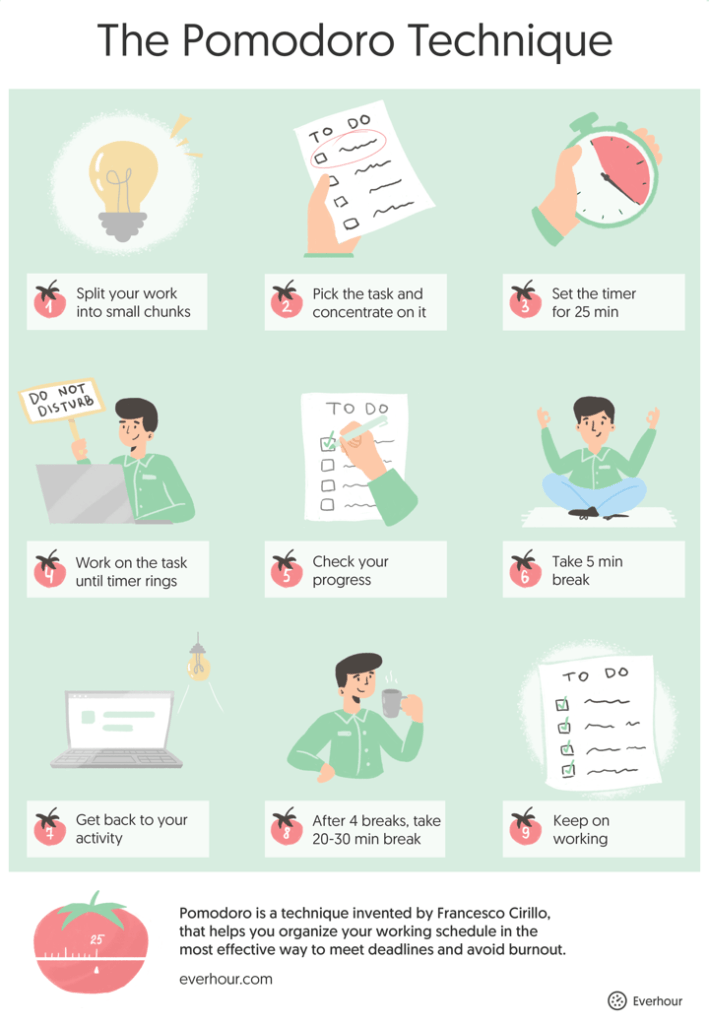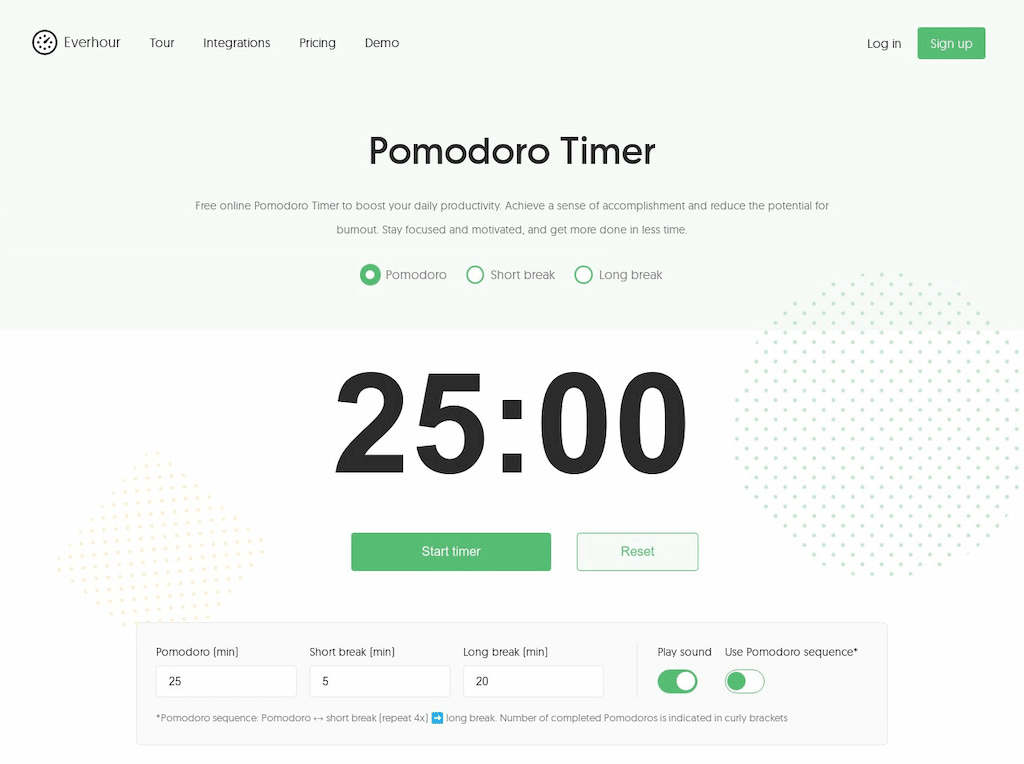One of the time management techniques that has been gaining hype recently is the Pomodoro technique and a Pomodoro timer. Tools like a free time card calculator can complement this approach by helping you track how long you’re spending on tasks. In this article, we gauge the Pomodoro technique’s pros and cons, to find out how it helps you manage your time better.
Understanding the Pomodoro Technique: How It Helps Manage Time
Pomodoro is a technique that helps you organize your working schedule in the most effective way to meet deadlines and avoid burnout.
It was invented by Francesco Cirillo, an Italian who experimented with time management solutions and came up with the idea to use a simple kitchen timer in the shape of tomato to organize his daily routine. 🍅
Right now, you might be asking yourself: how can kitchen utensils help manage serious projects? This isn’t an at-home technique only. In fact, the method is employed even in big companies.
In short: “If you work in a quiet environment and like discipline and structure, then the Pomodoro technique can be an extremely effective and satisfying way to make quick progress on a project or task. It’s excellent when you have everything you need to complete your work; you just need to sit down and do it.”
Who Is the Pomodoro Technique For?
Pomodoro is highly used by both contractors and freelancers. Among them are various content creators and those who are self-employed, thusly all profession types where self-organization is key to getting the work done.
Working from home is about more than a pleasant morning coffee and the absence of the necessity to run to the office in all weathers. Many treacherous distractions are waiting for you at every corner turn – the last season of your favorite series, social networks, and a full fridge. Keep up with that ‘just another 5 minutes’ mentality and the day is over before you know it.
For those who are just starting working from home, time management may seem especially hard. The Pomodoro technique and Pomodoro timer are an excellent way to switch smoothly from home leisure time to productive work.
But Pomodoro is not for remote workers only, companies can also successfully apply this time-management method to their teams on-site.
Benefits of the Pomodoro Technique in the Workplace
In the office environment, employees face different challenges that influence their productivity, perhaps even more so than at home:

- Open space office environment is great for inter-team communication and a love of tech companies worldwide. But when people can’t get away from friendly co-workers or any background noise which might catch their attention, they can lose their focus pretty fast.
- Multitasking approach. Need to complete a number of tasks within one day? Switching constantly between them wastes time and is not as effective as simple prioritizing.
- Unplanned or lengthy meetings. In the lead-up to a meeting or in the post-meeting comedown, employees can find themselves distracted and unable to concentrate, meaning their current tasks don’t get the attention they deserve.
With so many activities on their plate, in the attempts to meet deadlines, all the above lead to overworking and burnout.
The Pomodoro technique helps to reduce the anxiety of time pressure, turning it into a motivator. The establishment of rules for teams to follow, for example, when an interaction is allowed only during breaks, helps to reduce the effects of any unplanned stimulus in the office.
Research shows that this pattern of including small breaks can help to build concentration and is relatively successful.
How to Use Pomodoro Technique? (+Infographics) 📋

- Choose the priority tasks you need to have done today;
- Estimate the overall work volume and then split up your workflow into small chunks called “Pomodoros” that can be completed in 25 mins increments;
- Add these tasks to your plan (a project management tool or just a piece of paper);
- Pick a task, set a pomodoro timer for 25 minutes, and minimize distractions. Switch off your phone, keep focused on the activity here and now;
- Stop when time is up and make a note;
- Take a deserved break. Stretch your back, have a sip of water. After a 5-minute break you should get back to another Pomodoro;
- As soon as you have finished 4 pomodori, fully recharge your batteries with a 20-30 minute, so leave your desk;
- Repeat the session again!
Such a cycle of intense focusing and relaxing trains your brain to keep to a set schedule, improving your concentration, tackling procrastination which seems unbeatable for many. It positively influences the quality of your results, boosts productivity, and helps you meet deadlines.
Top Pomodoro Apps for Effective Time Management
- Everhour’s Pomodoro timer is a great option if you’re looking for a native Pomodoro tracker that works on majority of browsers – Chrome, Firefox, Microsoft Edge, Safari etc., and is available on any device. It’s super easy to setup and use. Besides, it’s absolutely free!

If Everhour is not enough, here you can find a list of the best Pomodoro apps that can help you to boost your productivity.
How to Best Use Breaks?
- Do eye exercises to improve eyesight;
- Drink a glass of water;
- Stand up, stretch your legs and neck, rub your hands to improve blood circulation, or moisturize them with lotion;
- Go outside to breathe fresh air which your brain needs more than anything;
- In one word — change your mental activity to any physical one;
The Challenges of Using Pomodoro Technique
No method is perfect and Pomodoro is no exception. Let’s have a look at the situations where it may not work quite so well:
- Specific environment. Calm and peace are the best friends of concentration, so to keep it you’ll have to avoid noisy places and people. This is often hard to achieve when you work in a team or your daily routine requires communication with dozens of people. If your whole office is chatting while you work, this technique may not be effective for you.
- Physical needs. Some claim that Pomodoro is a rigid system that doesn’t tolerate any interruptions. So, if you, let’s say want to eat or take a bathroom, you’ll lose precious ‘work time’ instead of concentrating. Although this is a strict interpretation of the rules, many apps have got a pause button. However, when you pause your work too often, the idea of Pomodoro becomes meaningless as you need to regain that concentration level again and again.
- No definite rules. Different people have different ways to rest and work. Some love listening to music while working; others prefer to scroll their newsfeed during rest. The Pomodoro technique has no specific rules on how to behave when working or resting. Indeed, our brains rest better while we sleep, meditate or exercise. Watching films or reading the news is not the best way to relax; meaning that you are constantly focusing and don’t let your mind calm down.
- Planning. Before getting to work, the Pomodoro technique implies that you plan, divide and measure your tasks. This may be quite hard to achieve, as plans can change quickly with unexpected situations occurring throughout the day. Moreover, dividing tasks by exact 25 min units need extra training to complete them correctly.
Final Words
The Pomodoro technique is a great helper and motivator for those who want to achieve their goals. But, this method doesn’t suit everyone, and for some, it may even seem like a real tyranny.
For employers considering proposing Pomodoro to their employees, remember that anyone who wants to try it should have a sense of responsibility for it to be effective. Ensure that the workload is manageable and achievable, allowing employees to get their “reward” of work completed at the end of those increments.
In any case, you won’t lose anything if you just give it a go, or try out some other best productivity apps or best time tracking apps.
If you are managing a team of 5 or more and looking to boost efficiency, Everhour is the perfect tool to keep your team on track. With seamless time tracking, you can easily estimate task durations, set clear budgets, and generate detailed reports inside Asana, Trello, Jira, or any other pm tool.

